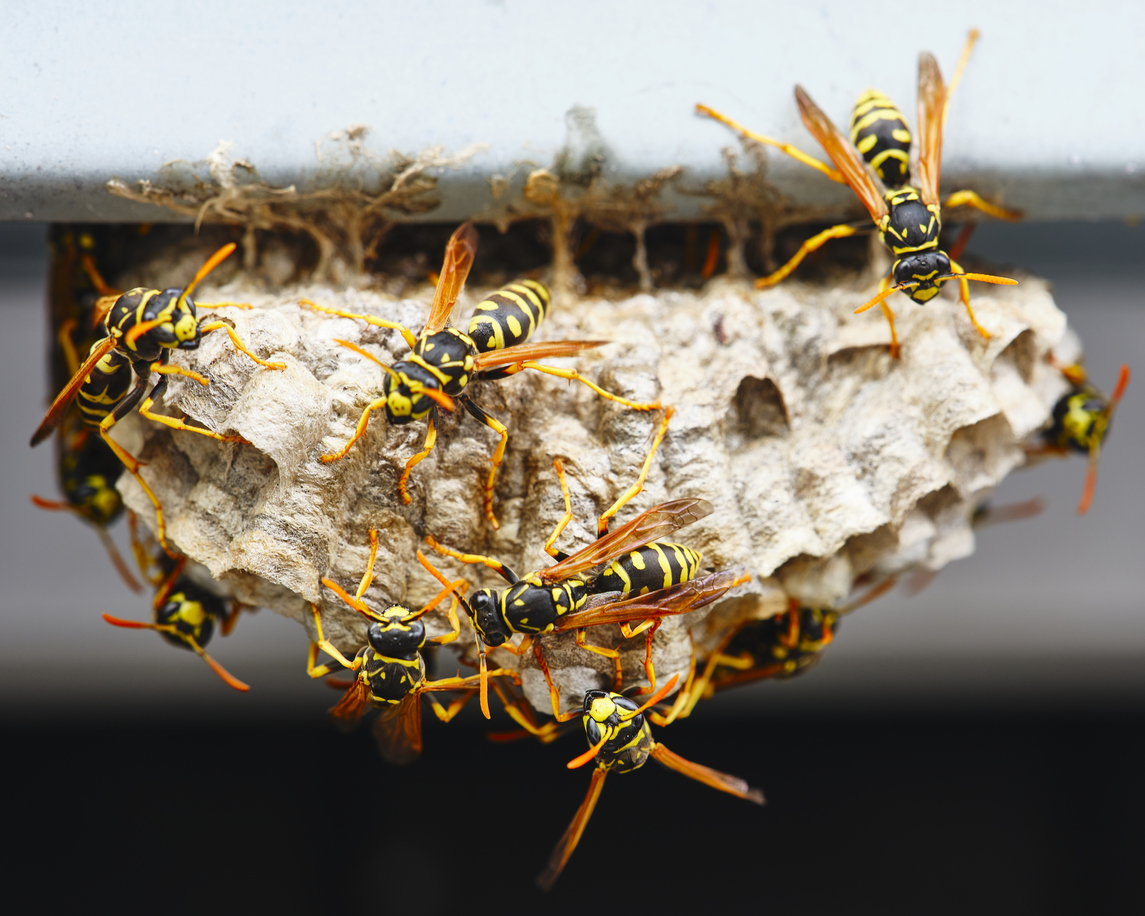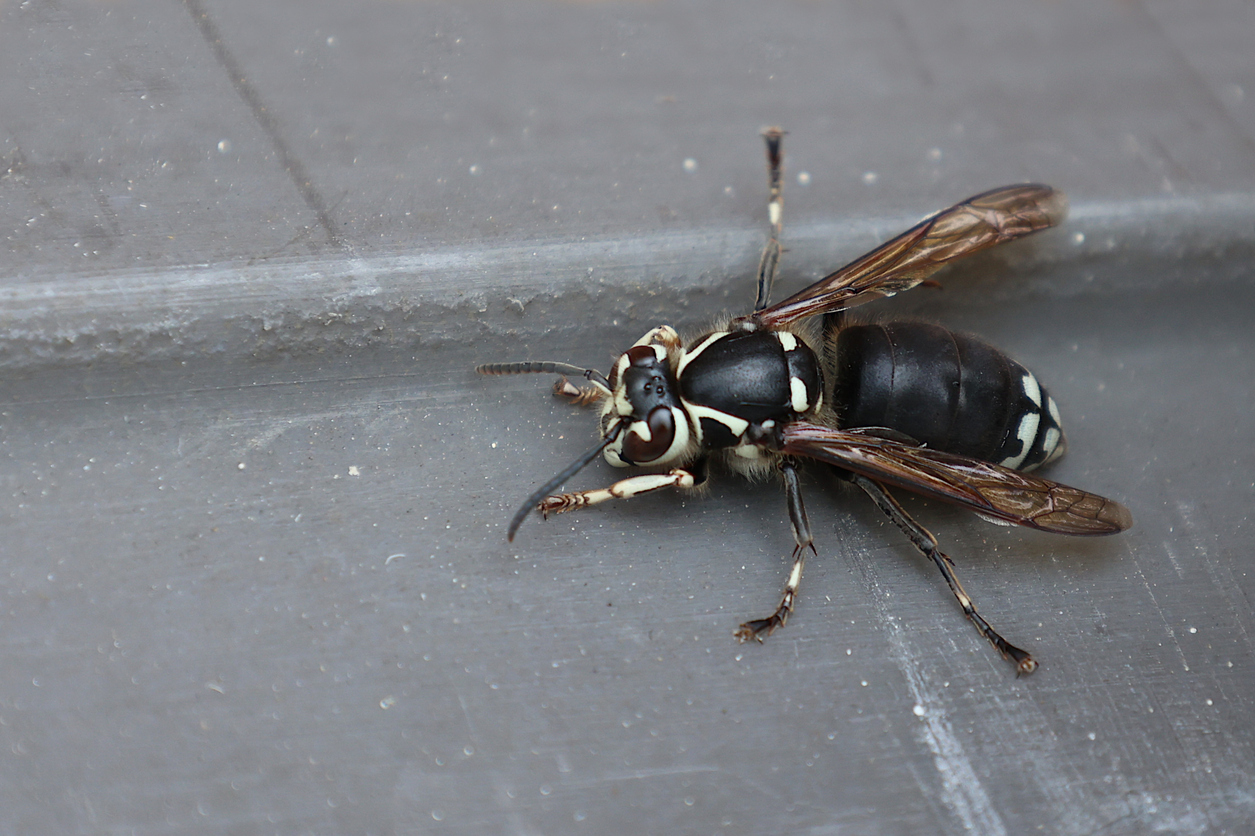Hornets
Common Pest: Hornets
Hornet is a name applied to a group of social wasps that make their nests of papery material chewed from tree bark or plant foliage. The nest can be very large in size and can be surrounded by many tissue thin layers like a paper envelope. Three species of hornets commonly encountered are the Bald Faced Hornet, the European Hornet and the Yellow Jacket. This insect has three body parts: a head, thorax and abdomen (the latter of the two being separated by a narrow band) jointed legs, antennae and it belongs to the family Vespa.
New queens emerge in the spring
They begin to build a small paper nest in which eggs are laid. Once the eggs hatch from the first 30 to 50 brood cells, they are then cared for by the queen for approximately the next 20 days. The larvae mature, pupate and grow into new workers. The workers are actually infertile females that take over the responsibility of nest expansion, foraging for food, care of the queen, larvae and defense of the colony. There is a unique interdependent relationship between the workers and the larvae called Trophlaxis. The workers provide essential care for the larvae at the same time become dependent on the larvae for their survival. Adults primarily feed on sugar and carbohydrates, while larvae prefer a more carnivorous diet of meat, fish and other insects. The adult workers only hunt and kill to feed the larvae, who in turn produce a sugary substance that is then fed back to the adult. When the nest is at peak size by early fall, reproductive cells are built where fertilized males, called drones, and new queens are housed. Drones have no stingers and once fertilized become the male reproducers of the colony. Adult reproducers leave the colony and after mating, the males quickly die off while the newly fertilized queens seek hospitable shelter to over winter. These become next year’s queens. The rest of the entire population produced during the year will not survive the winter and will soon die. Hornets rarely, if ever, reuse last year’s nests.
New queens emerge in the spring
They begin to build a small paper nest in which eggs are laid. Once the eggs hatch from the first 30 to 50 brood cells, they are then cared for by the queen for approximately the next 20 days. The larvae mature, pupate and grow into new workers. The workers are actually infertile females that take over the responsibility of nest expansion, foraging for food, care of the queen, larvae and defense of the colony. There is a unique interdependent relationship between the workers and the larvae called Trophlaxis. The workers provide essential care for the larvae at the same time become dependent on the larvae for their survival. Adults primarily feed on sugar and carbohydrates, while larvae prefer a more carnivorous diet of meat, fish and other insects. The adult workers only hunt and kill to feed the larvae, who in turn produce a sugary substance that is then fed back to the adult. When the nest is at peak size by early fall, reproductive cells are built where fertilized males, called drones, and new queens are housed. Drones have no stingers and once fertilized become the male reproducers of the colony. Adult reproducers leave the colony and after mating, the males quickly die off while the newly fertilized queens seek hospitable shelter to over winter. These become next year’s queens. The rest of the entire population produced during the year will not survive the winter and will soon die. Hornets rarely, if ever, reuse last year’s nests.
In the eat-or-be-eaten world of insects
Where carnage and mayhem are a daily way of life, the hornet has established its airborne supremacy. It is like the attack helicopter of the wasp family. This social insect communicates in many ways including the use of pheromone scents that are only perceptible to other family members. If you encounter a nest, NEVER swat a wasp. Killing a hornet in the vicinity of the nest promises to be a bad idea as the distress signal can trigger an all out assault. They have the ability to mobilize the entire nest to sting in defense. The distress pheromone can be used to communicate the need for an air attack on unsuspecting prey. Never kill a hornet on your body. Materials, like clothing, can come in contact with the distress pheromone turning you into a human radar guidance system, similar to a laser guiding a missile to its target. Hornets can sting multiple times, their stingers (unlike the stinger of a honey bee) is not barbed and they use it repeatedly for killing their prey. The sting of a hornet is more painful than the sting of a wasp because of the higher concentration of acetylcholine (about 5%). While having big guns in back, they can also bite their prey at the same time. Mouthparts are well developed with strong mandibles for capturing & chewing insects. Hornets have a beneficial side because the preferred food source is many pest species of caterpillars.
In the eat-or-be-eaten world of insects
Where carnage and mayhem are a daily way of life, the hornet has established its airborne supremacy. It is like the attack helicopter of the wasp family. This social insect communicates in many ways including the use of pheromone scents that are only perceptible to other family members. If you encounter a nest, NEVER swat a wasp. Killing a hornet in the vicinity of the nest promises to be a bad idea as the distress signal can trigger an all out assault. They have the ability to mobilize the entire nest to sting in defense. The distress pheromone can be used to communicate the need for an air attack on unsuspecting prey. Never kill a hornet on your body. Materials, like clothing, can come in contact with the distress pheromone turning you into a human radar guidance system, similar to a laser guiding a missile to its target. Hornets can sting multiple times, their stingers (unlike the stinger of a honey bee) is not barbed and they use it repeatedly for killing their prey. The sting of a hornet is more painful than the sting of a wasp because of the higher concentration of acetylcholine (about 5%). While having big guns in back, they can also bite their prey at the same time. Mouthparts are well developed with strong mandibles for capturing & chewing insects. Hornets have a beneficial side because the preferred food source is many pest species of caterpillars.
There are three main types of hornet.
The Bald Faced Hornet is medium in size (about 3/4 of an inch), is black with white markings on the body and face thus, giving it the appearance of being “bald.” It builds its nest high off of the ground, usually suspended on a tree branch or the under hang of a building. The large football shaped nest can attain a size of several feet and may contain several hundred to several thousand insects. The nest is easily identifiable by its grayish color and single opening located at the bottom. Bald-faced hornets can attack with very little provocation and have been seen scavenging on meat.
There are three main types of hornet.
The Bald Faced Hornet is medium in size (about 3/4 of an inch), is black with white markings on the body and face thus, giving it the appearance of being “bald.” It builds its nest high off of the ground, usually suspended on a tree branch or the under hang of a building. The large football shaped nest can attain a size of several feet and may contain several hundred to several thousand insects. The nest is easily identifiable by its grayish color and single opening located at the bottom. Bald-faced hornets can attack with very little provocation and have been seen scavenging on meat.
The European Hornet
Is fairly impressive being about 1 1/2 inches in size (the female being slightly larger of the two), is brown in color with yellow markings on its body. They dominate the middle stratosphere and typically build their nest in a cavity such as the hollow of a tree or wall void, which is usually a few meters (around six feet) off the ground. You may see only the edges of the paper extruding out from the void. The European Hornet is best known for its propensity to forage at night.
The Yellow Jacket
Is the smallest of the group being about a 1/2 inch in length but are fast fliers. They are black with yellow markings on their body (almost resembling stripes) they build their nest in low-lying structures or in the ground. The nest has one entrance point and multiple exit holes. They have a diet consisting mainly of sweets and protein. Yellow Jackets are potentially more aggressive toward humans because they are attracted to similar food sources, like the sugar in soda that collects around the rim of the can and human waste products like debris in a garbage can. It’s a good idea to always practice rigid cleanliness procedures around picnic areas.


Encounters with these insects can be commonplace during the summer months
With contact being as casual as sweeping a single wasp from the inside of your car with a rolled up newspaper, to the not-so-simple contact like running over an in-ground nest while cutting grass. These nests can reach multiple thousands of individuals by the height of their season. (Being on the receiving end of one well-placed sting while on a job site resulted in my eye being blackened and closed for over a week!) Multiple stings can send you to the hospital, a single sting to a person who has an allergy can cause them to go into anaphylactic shock and possibly die. This is definitely an insect not to be underestimated.
If you notice hornet nesting activity in your yard or around your house, please take my advice and invest in the professional extermination provided by Bugs By Brian immediately to eliminate this unwanted pest from your home or business. You’ll be glad you did.
St. Louis, Missouri
Email: scheduling@bugsbybrian.com
Call: (636) 394-0101
Location: 1401 Marsh Ave., Ellisville MO 63011
Melbourne, Florida
Email: scheduling@bugsbybrian.com
Call: (321) 674-1665
Location: 3830 S. Highway A1A Suite, 4135 Melbourne Beach, FL 32951
Ready to get started?
We offer free, no obligation estimates for all our pest control services.
Follow us on our social media plateforms


